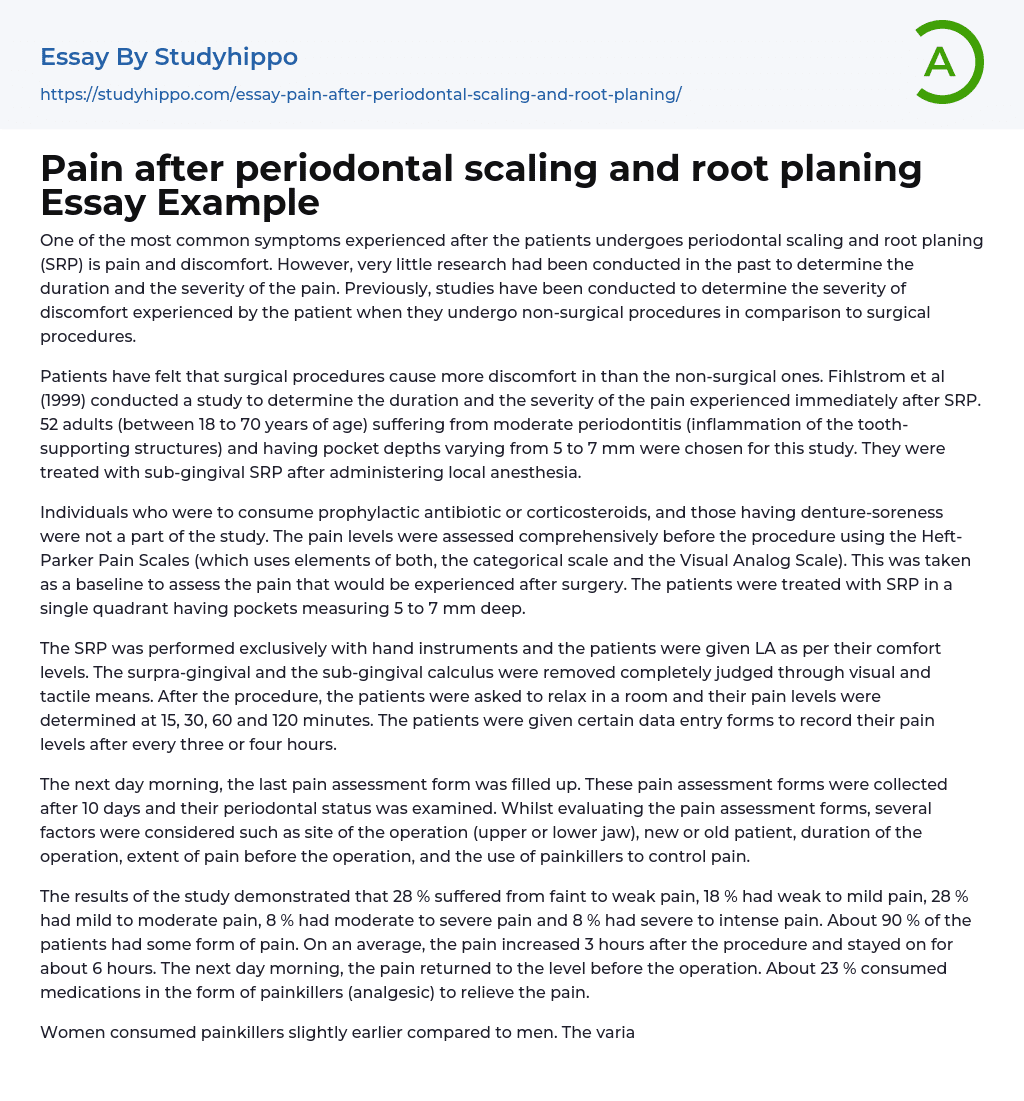

Pain after periodontal scaling and root planing Essay Example
One of the most common symptoms experienced after the patients undergoes periodontal scaling and root planing (SRP) is pain and discomfort. However, very little research had been conducted in the past to determine the duration and the severity of the pain. Previously, studies have been conducted to determine the severity of discomfort experienced by the patient when they undergo non-surgical procedures in comparison to surgical procedures.
Patients have felt that surgical procedures cause more discomfort in than the non-surgical ones. Fihlstrom et al (1999) conducted a study to determine the duration and the severity of the pain experienced immediately after SRP. 52 adults (between 18 to 70 years of age) suffering from moderate periodontitis (inflammation of the tooth-supporting structures) and having pocket depths varying from 5 to 7 mm were chosen for this study. They were treated with s
...ub-gingival SRP after administering local anesthesia.
Individuals who were to consume prophylactic antibiotic or corticosteroids, and those having denture-soreness were not a part of the study. The pain levels were assessed comprehensively before the procedure using the Heft-Parker Pain Scales (which uses elements of both, the categorical scale and the Visual Analog Scale). This was taken as a baseline to assess the pain that would be experienced after surgery. The patients were treated with SRP in a single quadrant having pockets measuring 5 to 7 mm deep.
The SRP was performed exclusively with hand instruments and the patients were given LA as per their comfort levels. The surpra-gingival and the sub-gingival calculus were removed completely judged through visual and tactile means. After the procedure, the patients were asked to relax in a room and their pain levels were determined a
15, 30, 60 and 120 minutes. The patients were given certain data entry forms to record their pain levels after every three or four hours.
The next day morning, the last pain assessment form was filled up. These pain assessment forms were collected after 10 days and their periodontal status was examined. Whilst evaluating the pain assessment forms, several factors were considered such as site of the operation (upper or lower jaw), new or old patient, duration of the operation, extent of pain before the operation, and the use of painkillers to control pain.
The results of the study demonstrated that 28 % suffered from faint to weak pain, 18 % had weak to mild pain, 28 % had mild to moderate pain, 8 % had moderate to severe pain and 8 % had severe to intense pain. About 90 % of the patients had some form of pain. On an average, the pain increased 3 hours after the procedure and stayed on for about 6 hours. The next day morning, the pain returned to the level before the operation. About 23 % consumed medications in the form of painkillers (analgesic) to relieve the pain.
Women consumed painkillers slightly earlier compared to men. The variation in pain between the sexes may be because of certain sensory factors, rather than emotional or behavioral. Pain lingered for a slightly longer durations in the maxilla (6. 3 hours) compared to the mandible (5. 6 hours). The pain was experienced for slightly longer durations in patients new compared to old patients. It was found that the pain present before the procedure and the duration of the procedure were not related to intensity
of pain recorded after the procedure.
Linear scales were utilized to describe the intensity of the pain. It was found to be more intense between 2 to 6 hours after the procedure. Following an SRP, the dental practitioner may have to administer painkillers to reduce mild to moderate pain. The painkiller should exert its effects within 2 hours and up to eight hours after the procedure, when it is maximal. The study has demonstrated that painkillers are usually not required the following day after the procedure, as the pain usually subsides.
- Central Nervous System essays
- Animals essays
- Charles Darwin essays
- Agriculture essays
- Archaeology essays
- Moon essays
- Space Exploration essays
- Sun essays
- Universe essays
- Birds essays
- Horse essays
- Bear essays
- Butterfly essays
- Cat essays
- Dolphin essays
- Monkey essays
- Tiger essays
- Whale essays
- Lion essays
- Elephant essays
- Mythology essays
- Time Travel essays
- Discovery essays
- Thomas Edison essays
- Linguistics essays
- Journal essays
- Chemistry essays
- Biology essays
- Physics essays
- Seismology essays
- Reaction Rate essays
- Roman Numerals essays
- Scientific Method essays
- Mineralogy essays
- Plate Tectonics essays
- Logic essays
- Genetics essays
- Albert einstein essays
- Stars essays
- Venus essays
- Mars essays
- Evolution essays
- Human Evolution essays
- Noam Chomsky essays
- Methodology essays
- Eli Whitney essays
- Fish essays
- Dinosaur essays
- Isaac Newton essays
- Progress essays



